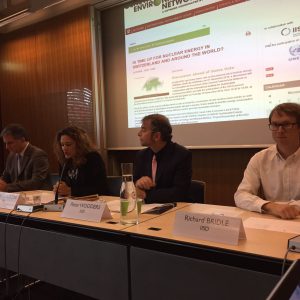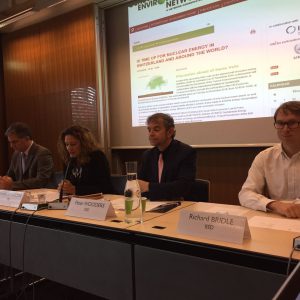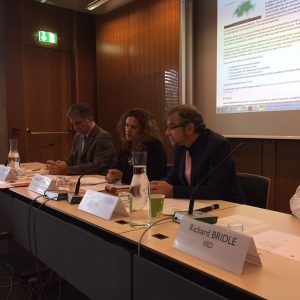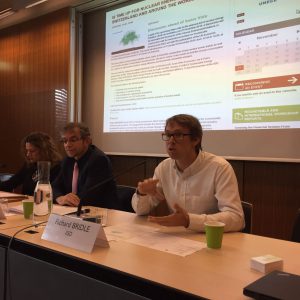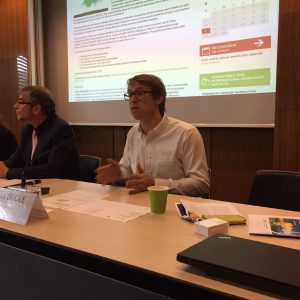Event Conference
Is time up for Nuclear energy in Switzerland and around the world?

22 Nov 2016
12:45–14:00
Venue: International Environment House II
Organization: Geneva Environment Network
Discussion ahead of Swiss Vote
In light of the Swiss vote on the planned exit of nuclear energy (Initiative «Sortir du nucléaire») on 27 November 2016, a discussion was organized within the framework of the Geneva Environment Network, in collaboration with the International Institute for Sustainable Development (IISD) and with the participation of the UN Economic Commission for Europe (UNECE). This event took place on Tuesday 22 November 2016, from 12:45 to 14:00, at the International Environment II (7.9 Chemin de Balexert).
The focus was on the popular initiative which seeks to forbid the construction of new nuclear power plants as well as to limit the duration of exploitation of power plants already in service. It also wants to limit the energy consumption as a whole, to improve the country’s energy efficiency and to promote renewable energies.
The event was chaired by Nathalie BERNASCONI-OSTERWALDER, head of the Economic Law & Policy programme of IISD. Short inventions will be made by Scott FOSTER, Director of UNECE Sustainable Energy Division, Peter WOODERS, IISD’s Group Director on Energy, and Richard BRIDLE, Project Researcher at the IISD Global Subsidies Initiative and was followed by an open discussion.
The event addressed the following topics:
- Potential risk of old power plants
- Alternatives to nuclear energy
- The Incentives for switching to renewables
- Consequences on CO2 emissions
- The cost of dismantling power plants and the question of nuclear waste
Panel
Peter WOODERS leads IISD’s Energy programme, which supports countries move to and deepen the sustainability of their energy systems. The programme includes the Global Subsidies Initiative, supportive work on fiscal policy including the green economy, IISD’s work on climate change mitigation and a pillar focusing on sustainable electricity systems. Peter has worked in almost every area of the energy economy, including energy efficiency, electricity sector planning, renewables, CCS, nuclear power and upstream oil and gas. He has worked on climate change issues for over 15 years, with a recent focus on competitiveness. Peter has worked in over 25 countries. His current focus is in the developing world, notably: Egypt; India; Indonesia; Nigeria; Viet Nam; and other countries of South-East Asia and MENA.
Scott FOSTER is the Director at the Sustainable Energy Division at United Nations Economic Commission for Europe (UNECE). Mr. Foster has more than 30 years of experience in global gas and power with the International Energy Agency, CERA, AES, ECON Energia and Global Insight. At UNECE, he manage the energy team and is responsible for development of and delivery on the energy programme on behalf of 56 member States, with particular focus on sustainable energy, including energy efficiency, clean electricity production from coal and other fossil fuels, renewable energy, natural gas, coal mine methane, fossil and mineral classification, and energy security.
Richard BRIDLE is a Project Researcher at the IISD Global Subsidies Initiative. His research interests include efficient design of renewable energy support policies, biofuels, green industrial policy and energy subsidies. Richard has a background in the renewable energy industry with experience in policy analysis, project management, development and procurement. He has played key roles in the successful realization of a number of large scale renewable energy projects and has participated in national and international fora on renewable energy policy.
Nathalie BERNASCONI-OSTERWALDER is the head of the Economic Law & Policy programme of the IISD. She works with developing country governments across Africa, Asia and Latin America in relation to bilateral and regional investment treaty negotiations, investor-state contracts (with a particular focus on mining and agriculture), model investment treaties and foreign investment laws. Nathalie has extensive legal, policy, and training experience in the area of international trade, investment, sustainable development, human rights, international environmental law and arbitration.
Summary
WELCOMING REMARKS
Nathalie Bernasconi-Osterwalder opened the dialogue explaining that IISD initiated with the Geneva Environment Network Secretariat discussions ahead of Swiss votes, the first two being on the initiative to restrict financial institutions to speculate on food (February 2016) and the Green Economy initiative (September 2016). These issues discussed in Switzerland are relevant for the international work of all environmental and international actors active in the area of energy, climate change, renewables and investment, among others. Today, she announced, the Swiss vote will be approached in an international context. Nathalie gave an outline of the upcoming discussion, which will tackle the issues of the potential risks of nuclear power plants, the costs of dismantling these facilities, the incentives for switching to renewables, the options for dealing with nuclear waste; and how all of these questions fit into the Sustainable Development Goals (SDGs) context.
THE NUCLEAR SITUATION IN SWITZERLAND
Richard Bridle, Project Researcher at the IISD Global Subsidies Initiative, first gave a short overview of the history of the initiative. He introduced Switzerland’s mix of main power sources, hydroelectricity and nuclear, as a situation that has carried on for many decades, leaving other technologies such as solar, wind, biofuel and waste on the side. Nuclear power in Switzerland first started with small thermal electricity producing reactors, which was shut down after an accident. After this event, the Swiss stopped their efforts to develop a national model of nuclear reactors and turned to the United States’ technology. Nonetheless, two plants projects were abandoned after the Chernobyl disaster in 1986.
Richard introduced the proposal, which seeks to close all nuclear power plants as soon as they reach 45 years of age. Five nuclear plants are directly concerned: Leibstadt (Argovie, in activity since 1984), Mühleberg (Berne, in activity since 1972), Gosgen (Soleure, in activity since 1979) and Beznau I and II (Argovie, respectively in activity since 1969 and 1971). Three of the oldest seven operational nuclear power plants stations in the world are in Switzerland, he explained. The acceptance of the popular proposal would thus imply that Beznau I – the oldest power plant operating anywhere in the world – would have to close by November 2017, along with Beznau II and Mühlberg; while Gösgen would close in 2024 and Leibstadt in 2029.
“Switzerland is a highly inter-connected country when it comes to energy.”
Switzerland is a highly inter-connected country when it comes to energy, explained Richard. In 2014, the country imported 33,527 GHW and exported 33,833 GHW, which made for a total transit of 27,752 GHW with France, Germany, Austria and Italy. Finally, Richard gave further insights into the complexity of the Swiss energy situation, with the Cantons owning all of the power (87%), thus including the nuclear power plants through a public-private ownership of shares.
POTENTIAL RISKS FOR OLD POWER PLANTS
Peter Wooders, IISD’s Group Director on Energy, introduced the problem of nuclear risk. He explained that in almost any country we looked at, there was in general a very small risk of nuclear accident, however the consequences of a potential accident were enormous. The question thus remained whether we believed that this small risk was worth taking. This risk is not quantifiable, he explained, it is only a matter of popular opinion.
“The potential risk of old power plants remains a question of trust in the safety authorities.”
As pressure vessels age, the chances of accident increase, noted Peter. Micro cracks get formed and, over time, the chances of big cracks rise. The message given by most countries is that nuclear plants are deemed to last for 40 years; and most were built in the 1970s. Today, numerous amounts of tests are ran on the pressure vessels in order to decide the plant is still safe or not. However, some issues can arise without warning, just as it happened with Fukushima’s cooling system.
Scott Foster, Director of UNECE Sustainable Energy Division, gave an insight about his own vision of risk management. He explained all nuclear accidents which have happened in the past, including Chernobyl and Fukushima, were due to human and institutional factors. In this regard, he agreed with Peter on the fact that the real question is whether citizens trust the regulatory body which oversees nuclear security.
ALTERNATIVES TO NUCLEAR ENERGY IN SWITZERLAND AND IN THE WORLD
The Swiss authorities have launch their 2050 energy strategy, explained Peter, meaning that by 2020 most of renewables such as wind, wood, biogas and geothermal will see a small increase in energy use. However, renewable energy remain held up by a struggling system of feed tariffs. In this regard, Switzerland has less solar and wind energy than most European countries and there is room for improvement.
As an example to potential alternatives, Richard gave the example of a study conducted by the Swiss Federal Institute of Technology in Lausanne (EPFL), which, by using a GIS model to analyse the orientation of roofs in the country, found that and if the roofs which had the correct solar orientation were covered by solar panels, it would be possible to make they could account for 40% of all Swiss energy by 2050.
The Sustainable Development Goal 7 is about energy (Ensure access to affordable, reliable, sustainable and modern energy for all), and it appears everywhere in the whole SDG process, introduced Scott Foster. Today, 80% of the world’s primary energy mix is still fossil. We need to think about how this challenge is going to be addressed, and every technology really does have its rule to play, states Scott. In this regard, two solutions are possible.
There should first be incremental changes in how energy is currently being traded. If a market in which energy suppliers are able to deliver energy services directly to the consumers was to be created, mind-sets and business models would start to shift. This would allow anyone to directly invest in renewables. It is thereof important to conceive a smart energy system, in which there is a fair access to the network and to the consumers. This energy system would need to be re-conceived so that it would rely on free exchanges, and go beyond national borders. A mutually beneficial economic interdependence will allow competitive costs for all forms of energy, and as nuclear energy is more expensive in comparison to solar or gas, this system will indubitably promote renewables.
“There should be incremental changes in how energy is currently being traded.”
Secondly, Scott added, energy efficiency could be greatly improved, as by better using the fossil energy, it is possible to reduce our consumption. This could work by setting a real price on carbon, and only a price above 100 euros per ton would be truly efficient.
In response to his colleague, Richard shared his worries on the fact that relying only on market mechanisms for galvanising renewables may take too long to produce a shift in that direction.
THE INCENTIVES FOR A SWISS SHIFT TO RENEWABLES
Hydroelectricity is the factor that gives Switzerland all of its energy flexibility announced Peter. It can be stocked, and replace solar power when this latter is not at its fully functional capacity. By being inter-connected with its neighbours, Switzerland is in the full capacity to be independent on renewables, by exporting and importing following the energy demands.
“Hydroelectricity is the factor that gives Switzerland all of its energy flexibility.”
Who wants to pay the costs of nuclear energy’s early closure, when the renewables are not yet competent, questioned Scott Foster in this regard. He affirmed that shutting down prematurely could provoke issues on the energy market. However, Switzerland interconnectedness allows it to be part of the discussion on the energy market, and will ultimately be an opportunity for the country’s shift to renewables.
Richard also offered his point of view on the matter. As around 40% of the Swiss energy is issued from nuclear power, this signifies that around 15% of the current generation capacity would need to be replaced after by 2017 if the initiative was to be accepted. We could thus wonder whether this transition is too fast, said Richard. However, he wondered, would the question of replacement capacity ever be brought up if there were no pressures for doing it? Would a shock be necessary in order to develop a new energy system based on renewables? And are the current incentives sufficient for doing it already today?
“Would a shock be necessary in order to develop a new energy system based on renewables?”
WHAT WOULD BE THE COST OF DISMANTLING POWER PLANTS?
Richard offered an example regarding the cost of de-commissioning nuclear sites by explaining that the United Kingdom’s bill in this regard currently accounts for 65% of its energy budget, a situation which will continue for the next 100 upcoming years.
DEALING WITH NUCLEAR WASTE
Peter took us through the issues with dealing with nuclear waste. All nuclear elements, he explained, start to decompose after they are used, and enter a time period during which they are incredibly hot and radioactive. For the time being, the common practice it to store these wastes in swimming pools for 20 years, after which they are safer to be treated. In Switzerland’s case, two potential sites were shortlisted in 2015 to act as permanent depositaries for nuclear waste, and a final decision will be taken by 2027 by the authorities to decide how this waste will be treated. This means there are no plans for dealing with nuclear waste for the time being. As more and more waste is being produced every day, should we keep developing nuclear energy when we do not have any solid plan to deal with the consequential wastes, wonders Peter Wooders.
In parallel to this issue, the question of the cost of dealing with this waste should also be taken into account, informs Peter Wooders. The Swiss authorities have estimated a total cost of 6 billion Swiss francs for treating all the nuclear waste which has been produced so far. In this regard, two funds have been lunched in 2002, aiming to reach a total amount of 6.1 million. Part of this money is issued from taxes. One of the governments’ main argument is that nuclear plants should keep running in order to fund the treatment of nuclear waste.
Scott Foster joined Peter Wooder’s arguments by explaining that the issue of waste disposal is not just a Swiss issue, however a global one, as more and more pools are created and most authorities do not know how to deal with the following stage. Other approaches have been proposed, announced Scott Foster, which consist in solidifying the waste, or in leaving the waste in container vessels and making the entire area restricted.
CLOSING REMARKS
Nathalie Bernasconi-Osterwalder closed the interactive dialogue by thanking all panellists for a dynamic discussion made up of good insights and welcomed the views originating from all backgrounds. She re-opened the question whether a kick was indeed needed to produce a renewables shift, and suggested that this might have been what the initiative had in mind by proposing such an ambitious phase out schedule.
More information and documents
LINKS:
- UNECE Energy: https://www.unece.org/energy.html
- Sustainable Development Goal 7: https://sustainabledevelopment.un.org/sdg7
- IISD Energy: http://www.iisd.org/program/energy
- IISD Subsidies: https://www.iisd.org/gsi/fossil-fuel-subsidies
https://www.genevaenvironmentnetwork.org/wp-content/uploads/2020/05/swiss_nuclear_energy.pdf
https://www.genevaenvironmentnetwork.org/wp-content/uploads/2020/05/summary_22_november_2016.pdf

